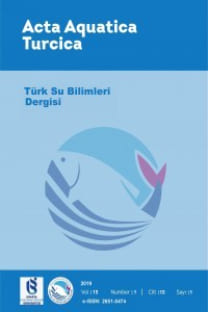Denizel Kaynaklardan Elde Edilen Biyoaktif Maddeler ve Kozmetik Alanında Kullanımı
Biyoaktif madde, kitosan, kozmetik, kollajen
Bioactive Substances Derived from Marine Resources and Their Usage in Cosmetic Industry
___
- Ariede, M. B., Candido, T. M., Jacome, A. L. M., Velasco, M. V. R., Carvalho, J. C. M., & Baby, A. R. (2017). Cosmetic attributes of algae - A review. Algal Research, 25, 483–487.
- Berber, B., Koşkun, M., Çakır, S., Tarhan, B., & Sesal, N.C. (2014). Kitosan nanoparçacıkların sentezi ve antimikrobiyal aktivitesinin araştırılması. 4. Kozmetik Kimyası, Üretimi, Standardizasyonu Kongresi, Kimyagerler Derneği, 14-16 Şubat, Antalya.
- Berillis, P. (2015). Marine collagen: extraction and applications. Research Trends in Biochemistry, Molecular Biology and Microbiology, 1-13.
- Bostan, K., Aldenir, T., & Aydın, A. (2007). Kitosan ve antimikrobiyal aktivitesi. Türk Mikrobiyol Cemiyeti Dergisi, 37(2), 118-127.
- Corinaldesi, C., Barone, G., Marcellini, F., Dell’Anno, A., & Danovaro, R. (2017). Marine microbial-derived molecules and their potential use in cosmeceutical and cosmetic products. Marine Drugs, 15, 118; doi:10.3390/md15040118.
- Demir, A., & Seventekin, N. (2009). Kitin, kitosan ve genel kullanım alanları. Tekstil Teknolojileri Elektronik Dergisi, 3(2), 92-103.
- El- Rashidy, A. A., Gad, A., Abu-Hussein, A. E. G., & Habib, S. I. (2015). Chemical and biological evaluation of Egyptian Nile Tilapia (Oreochromis niloticas) fish scale collagen, International Journal of Biological Macromolecules, 79, 618–626.
- Engin, B., Erkan, E., Çelik, U., Kutlubay, Z., & Serdaroğlu, S. (2016). Dermatolojide gıda takviyesinin önemi, gıda takviyesi, 1-14, http://www.dermatoz.org/2016/2/dermatoz16072d1.pdf, doi: 10.15624.dermatoz16072d1.
- Erdal, M. S. (2013). Temel krem ve nemlendirici formül tasarımı. 3. Kozmetik Kongresi, 15-17 Şubat, Antalya.
- Gao, X., Zhang, L., Wei, H., & Chen, H. (2008). Efficacy and safety of innovative cosmeceuticals. Clinics in Dermatology, 26, 367–374.
- Kim, Y. H., Chung, C. B., Kim, J. G., Ko, K., Park, S. H., Kim, J., EOM, S. Y., Kim, Y. S., Hwang, Y., & Kim, K. H. (2008). Anti-wrinkle activity of ziyuglycoside I isolated from a sanguisorba officinalis root extract and its application as a cosmeceutical ingredient, Bioscience, Biotechnology, and Biochemistry, 72(2), 303–311.
- Kim, S. (2012). Marine cosmeceuticals trends and prospects. Taylor&Francis Group, New York, 397s.
- Kim, S. ve Mendis, E. (2006). Bioactive compounds from marine processing byproducts – A review. Food Research International, 39, 383–393.
- Lupo, M. P. (2001). Antioxidants and vitamins in cosmetics. Clinics Dermatology, 19, 467-73.
- Majeti, N. V. & Kumar, R. (2000). A review of chitin and chitosan applications. Reactive & Functional Polymers, 46, 1–27.
- Morimura, S., Nagata, H., Uemura, Y., Fahmi, A., Shigematsu, T., & Kida, K. (2002). Development of an effective process for utilization of collagen from livestock and fish waste. Process Biochemistry 37, 1403–1412.
- Muxika, A., Etxabide, A., Uranga, J., Guerrero, P. & Caba, K. (2017). Chitosan as a bioactive polymer: Processing, properties and applications, International Journal of Biological Macromolecules, 105, 1358–1368.
- Raposo, M. F. J., Morais, A. M. M. B., Morais, R. M. S. C. (2014). Influence of sulphate on the composition and antibacterial and antiviral properties of the exopolysaccharide from Porphyridium cruentum. Life Sciences, 101, 56-63.
- Spolaore, P., Joannis-Cassan, C., Duran, E., & Isambert, A. (2006). Commercial applications of microalgae, Journal of Bioscience and Bioengineering, 101(2), 87-96.Şenol, F. (2016). Bitkisel kaynaklı kozmetik ürün geliştirilmesi üzerine farmakognozik araştırmalar. Doktora Tezi, Sağlık Bilimleri Enstitüsü, Gazi Üniversitesi, Ankara.
- Tırnaksız, F. (2005). Antioksidanların cilt bakım ürünlerinde kullanımı. http://www.eczaakademi.org/images/upld2/ecza_akademi/makale/20110113035937kozmetik2.pdf
- Wang, H. D., Li, X., Lee, D., & Chang, J. (2017). Potential biomedical applications of marine algae, Bioresource Technology, 244 :1407–1415.
- Wang, H. D., Chen, C., Huynh, P., & Chang, J. (2015). Exploring the potential of using algae in cosmetics. Bioresource Technology, 184, 355–362.
- Yapar, E. A. & Tanrıverdi, S. T. (2016). Yaşlanma karşıtı kozmetik yaklaşımlar ve ürün bileşenleri, Balıkesir Sağlık Bilimleri Dergisi, 5(2), 99-109.
- Yayın Aralığı: 4
- Başlangıç: 1988
- Yayıncı: Yunus Ömer BOYACI
Su Ürünleri Yetiştiriciliğinde Tıbbi Bitkilerin Anestezik Olarak Kullanımı
Seçil METİN, Öznur DİLER, Hakan DİDİNEN
Laktik Asit Bakterilerinin Balıklarda Büyüme Performansı Üzerindeki Etkileri
Nalan Özgür YİĞİT, Behire Işıl DİDİNEN, Seval BAHADIR KOCA, Tülay DEMİR
Eğirdir Gölü Su Kalitesinin Trofik Durum İndeksleriyle Belirlenmesi
İzmir’in Farklı Bölgelerinde Satışa Sunulan Midye Dolmaların Mikrobiyolojik Kalitesi
Berna KILINÇ, Burcu ŞEN YILMAZ, Buket GÖREN
Yumuşak Kabuklu Nil Kaplumbağası (Trionyx triunguis): Yuva parametreleri ve yeni bir yuvalama alanı
Erken Çocukluk Döneminde Balık Eti Tüketiminin Sağlıklı Gelişim Açısından Önemi
Ebru YILMAZ, Mehmet AYDIN, Arda YILDIRIM, Pınar ŞAHİN
Türk Mutfağında Su Ürünleri Kültürü ve Önemi
Gülgün F. Ünal ŞENGÖR, Zafer CEYLAN
Denizel Kaynaklardan Elde Edilen Biyoaktif Maddeler ve Kozmetik Alanında Kullanımı
Serap SAMSUN, Naciye ERDOĞAN SAĞLAM
Akdeniz için Kupesin Boops boops (Perciformes: Sparidae) Maksimum Boyu
